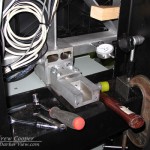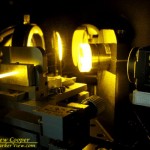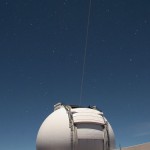One of the tasks I have helped with on the K1 AO Laser is aligning the Launch Telescope Assembly (LTA). This is not so much an electrical engineer’s task, but a mechanical one. So how did I end up with the task? Simple, I was present the first time it was done. Since the mechanical engineer who was first responsible has now left the observatory, I get the job by default. Just the way things work around here.
The launch telescope is a small telescope, about 0.5 meter in aperture, that projects the laser into the sky. Mounted behind the secondary mirror of the Keck 1 telescope, it must be precisely aimed to exactly the same spot in the sky the main telescope is aimed.

In practice this adjustment is about one to two hours crouched in the secondary assembly of the Keck 1 telescope. Each time the bolts are tightened the assembly moves about 10-15 thousandths of an inch. Thus I have to guess how much to offset the measurement so it ends up correct when the bolts are tight. It takes anywhere from three to five repetitions to get right sometimes.
This is where I curse the mechanical engineer who dreamed up the mounting for the launch telescope. I look at the dial indicators, shift my stance against the cold steel to stop the cramping, loosen the bolts and try again.
The last adjustment was a mere 0.004″ (four one-thousandths of an inch) to move the pointing about 30 arc-seconds on the sky. I am now only about 10 arc-seconds from the optical axis. Keep in mind that a single arc-second is 1/60th of an arc-minute, which is in turn 1/60th of a degree. Ten arc-seconds is pretty good, but we want closer. Here I go one more time…



